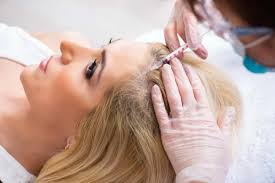Hair loss affects millions of people in the United States, making it a common condition. Platelet-rich plasma (PRP) therapy is a medical treatment option for addressing various types of hair loss. This treatment uses your body’s own healing mechanisms to potentially stimulate hair growth and improve hair density. Understanding the causes of hair loss and how PRP therapy works can help you make informed decisions about your treatment options.
What Is Hair Loss?
Hair loss, also known as alopecia, involves the thinning of hair on the scalp or excessive hair shedding. It may manifest in different ways, from a receding hairline to thinning at the crown. While numerous treatments exist, PRP, sometimes combined with microneedling, is a procedure used to address hair thinning and loss by stimulating hair follicles.
This condition can be temporary or permanent, depending on its underlying cause. Understanding the specific factors contributing to hair loss is the first step in identifying an appropriate course of action. A medical evaluation can help determine the cause of hair loss and identify suitable treatments.
What Causes Hair Loss?
Several factors can contribute to hair loss. Genetics plays a significant role, with hereditary conditions like male-pattern baldness and female-pattern baldness being common causes. These conditions are typically progressive and follow predictable patterns.
Hormonal changes may also lead to temporary or permanent hair loss. Events such as pregnancy, childbirth, and menopause can trigger hormonal shifts that affect hair growth cycles. Medical conditions, including thyroid problems and autoimmune diseases, are other potential causes that a healthcare provider diagnoses.
What Is PRP?
Platelet-rich plasma (PRP) is a concentrate of platelet-rich plasma protein derived from a person’s own blood. Plasma contains growth factors, which are proteins that help stimulate cellular growth and regeneration. The process involves drawing a small amount of blood from the individual.
The collected blood is then placed in a centrifuge, a machine that spins at a high speed to separate the blood components. This process isolates the platelets and plasma from other blood cells, creating a concentrated PRP solution. This solution is then prepared for injection into the scalp.
How Does It Work?
The PRP procedure involves injecting the concentrated plasma into the areas of the scalp affected by hair loss. The growth factors within the platelets stimulate the hair follicles, promoting new hair growth and increasing the thickness of the hair shaft. Treatment is typically performed in a clinical setting by a trained medical professional. The number of treatments and the time between them can vary based on individual needs and the treatment plan established by the provider.
What Are the Benefits?
PRP therapy offers several potential benefits for individuals experiencing hair loss. Since the treatment uses the patient’s own blood, there is a low risk of allergic reactions or transmissible infections. The procedure is minimally invasive, with injections being the primary method of application. Some individuals find that PRP may lead to an increase in hair count, hair thickness, and the length of the growth phase of the hair cycle, promoting thick and healthy hair.
Learn More About Hair Restoration
PRP therapy is a method for addressing hair loss by using the body’s own growth factors to stimulate hair follicles. Understanding the causes of hair loss and the mechanics of treatments like PRP can help you make an informed decision about your hair loss treatment. When evaluating hair restoration options, consulting with a qualified provider is beneficial. They can assess your specific condition and determine whether PRP is the proper treatment for you.
